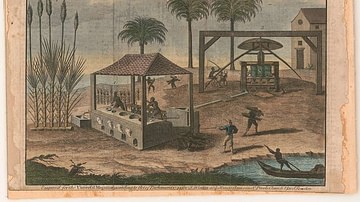Review

| Rating: | |
|---|---|
| Title: | An Archaeology and History of a Caribbean Sugar Plantation on Antigua (Florida Museum of Natural History: Ripley P. Bullen) |
| Author: | Georgia L. Fox |
| Audience: | University |
| Difficulty: | Easy |
| Publisher: | UNIV OF FLORIDA PR |
| Published: | 2020 |
| Pages: | 348 |
Georgia L. Fox's "An Archaeology and History of Caribbean Sugar Plantation on Antigua" offers a meticulous and interdisciplinary exploration of Betty's Hope, which was one of Antigua's most prominent sugar plantations. This book is a significant contribution to Eastern Caribbean historical archaeology, providing insights into colonialism, slavery, and environmental change.
This book is a collection of essays that blends archaeology, archival research, and environmental studies to examine the history and material culture of Betty's Hope, established in the 1650s by the Codrington family. Moreover, Fox, alongside a team of scholars, analyzed and dissected various facets of plantation life, including enslaved labor, agricultural practices, and the plantation's ecological footprint.
On Caribbean plantations like Betty's Hope, sugar reigned supreme - its cultivation dictated the rhythms of life, drove economies, and forged an empire built on the backs of the enslaved. The chapters will provide readers with detailed archaeological investigations and findings at Betty's Hope that give readers a window into the lives of enslaved Africans and the plantation's operational infrastructure and system. The author also provides discussions on the excavation of the windmill, cistern, production, equipment, and the lifestyle of enslaved laborers, revealing the ingenuity and resilience of the enslaved population despite oppressive conditions in slavery.
The book effectively conveys the idea that sugar was the driving force behind Caribbean colonialism, encapsulating the phrase “sugar was king.” Fox situates Betty’s Hope within the wider Atlantic world, where plantations served as profit-making machines for European empires. The book traces the exploitation of human labor, with enslaved Africans reduced to mere cogs in the machinery of sugar production. This systemic exploitation enabled the accumulation of wealth in Europe while impoverishing and dehumanizing those who labored under its weight in the Caribbean.
One of the book’s significant contributions lies in its nuanced portrayal of the enslaved. The analysis of material culture gives an insight into how enslaved people faced the harsh reality of living in a plantation society. While they had little control over their labor, enslaved individuals asserted agency in subtle but meaningful ways, such as in their foodways, religious practices, and community-building efforts. The recognition of these forms of resistance counters traditional narratives that depict enslaved populations as entirely subjugated.
This book also highlights the devastating environmental consequences of sugar cultivation. The plantation’s reliance on monoculture exhausted Antigua’s soil, while the need for constant water supply led to the construction of elaborate cistern systems and windmills. The ecological legacy of this exploitation persists today, and the book offers a critical reflection on how colonial environmental practices continue to shape Caribbean landscapes.
The book extends its analysis beyond the past, emphasizing the importance of preserving plantation sites like Betty’s Hope. She discusses the challenges of conservation in the 21st century, where such sites are simultaneously spaces of historical memory and painful reminders of exploitation. The restoration of Betty’s Hope, including its iconic windmills, raises questions about whose histories are prioritized in heritage narratives and how these spaces can foster meaningful engagement with the past for citizens.
The book has a variety of strengths that make it a very important publication on Antiguan history and archaeology. Fox’s ability to synthesize archaeology, history, and environmental science makes this book a standout contribution to Caribbean and historical studies. The archaeological data is seamlessly integrated with historical records and environmental investigations, providing a holistic understanding of plantation life in the Caribbean. Secondly, by centering the experiences of the enslaved people, the book challenges Eurocentric interpretations of plantation history. The analysis of artifacts and settlement patterns paints a vivid picture of the enslaved community’s resilience and creativity. Finally, the book situates Betty’s Hope within the global dynamics of the transatlantic slave trade and sugar production. This perspective highlights the topic of colonial economies and underscores the Caribbean’s pivotal role in shaping the Western world.
The only limitation of the book is that it provides an in-depth study of Betty’s Hope. It could have benefited from a more explicit comparison with other Caribbean plantations. This would have strengthened its claims about the universality and uniqueness of plantation practices in Antigua.
An Archaeology and History of a Caribbean Sugar Plantation on Antigua is a groundbreaking work that offers a profound understanding of the Caribbean plantation complex. By integrating archaeological evidence, historical documents, and environmental studies, Georgia L. Fox, Professor of Anthropology at California State University, Chico, and her collaborators provide a great view of Betty’s Hope as a microcosm of colonialism’s economic, social, and ecological impacts. This book is important reading material for scholars of Caribbean history, historical archaeology, and heritage studies.
About the Reviewer
Cite This Work
APA Style
Gordon, J. (2024, December 13). An Archaeology and History of a Caribbean Sugar Plantation on Antigua. World History Encyclopedia. Retrieved from https://www.worldhistory.org/review/499/an-archaeology-and-history-of-a-caribbean-sugar-pl/
Chicago Style
Gordon, Javíer. "An Archaeology and History of a Caribbean Sugar Plantation on Antigua." World History Encyclopedia. Last modified December 13, 2024. https://www.worldhistory.org/review/499/an-archaeology-and-history-of-a-caribbean-sugar-pl/.
MLA Style
Gordon, Javíer. "An Archaeology and History of a Caribbean Sugar Plantation on Antigua." World History Encyclopedia. World History Encyclopedia, 13 Dec 2024, https://www.worldhistory.org/review/499/an-archaeology-and-history-of-a-caribbean-sugar-pl/. Web. 29 Jun 2025.




